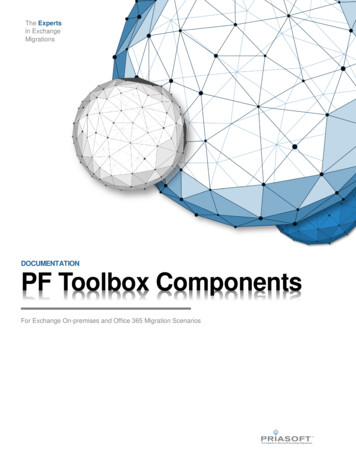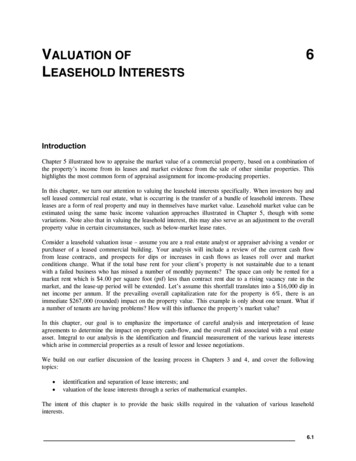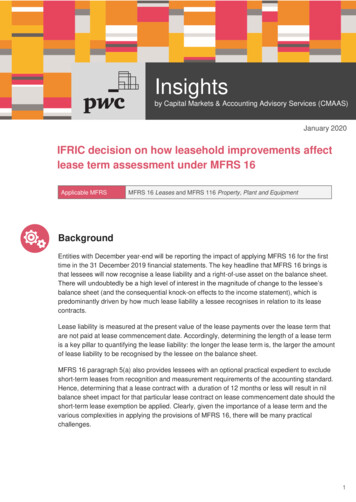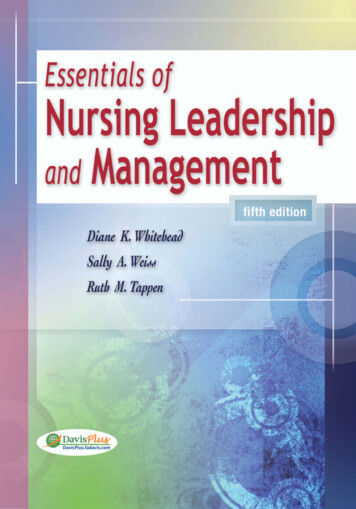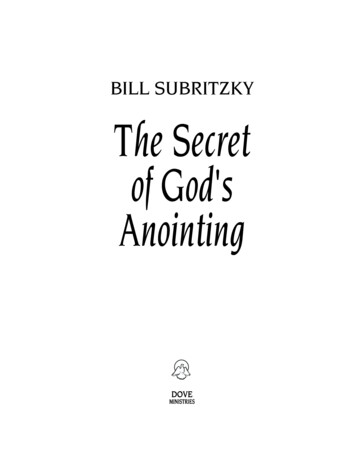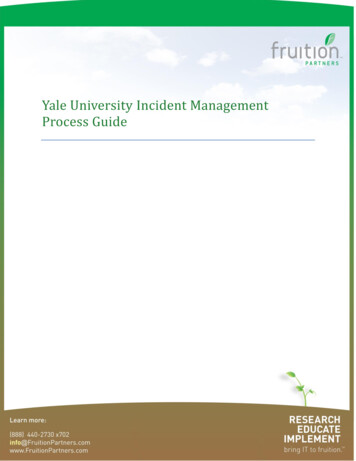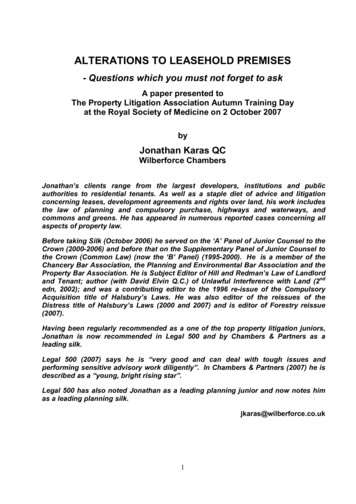
Transcription
ALTERATIONS TO LEASEHOLD PREMISES- Questions which you must not forget to askA paper presented toThe Property Litigation Association Autumn Training Dayat the Royal Society of Medicine on 2 October 2007byJonathan Karas QCWilberforce ChambersJonathan’s clients range from the largest developers, institutions and publicauthorities to residential tenants. As well as a staple diet of advice and litigationconcerning leases, development agreements and rights over land, his work includesthe law of planning and compulsory purchase, highways and waterways, andcommons and greens. He has appeared in numerous reported cases concerning allaspects of property law.Before taking Silk (October 2006) he served on the ‘A’ Panel of Junior Counsel to theCrown (2000-2006) and before that on the Supplementary Panel of Junior Counsel tothe Crown (Common Law) (now the ‘B’ Panel) (1995-2000). He is a member of theChancery Bar Association, the Planning and Environmental Bar Association and theProperty Bar Association. He is Subject Editor of Hill and Redman’s Law of Landlordand Tenant; author (with David Elvin Q.C.) of Unlawful Interference with Land (2ndedn, 2002); and was a contributing editor to the 1996 re-issue of the CompulsoryAcquisition title of Halsbury’s Laws. He was also editor of the reissues of theDistress title of Halsbury’s Laws (2000 and 2007) and is editor of Forestry reissue(2007).Having been regularly recommended as a one of the top property litigation juniors,Jonathan is now recommended in Legal 500 and by Chambers & Partners as aleading silk.Legal 500 (2007) says he is “very good and can deal with tough issues andperforming sensitive advisory work diligently”. In Chambers & Partners (2007) he isdescribed as a “young, bright rising star”.Legal 500 has also noted Jonathan as a leading planning junior and now notes himas a leading planning silk.jkaras@wilberforce.co.uk1
Introduction1.One question which we all usually remember to ask is whether the tenant ispermitted to carry out the alterations under the terms of the lease.2.This, however, is not the only matter to be considered when a tenant wishes toalter premises or has already carried them out. It is important also to ask threeother questions:(1)What is the impact of the Landlord and Tenant Act 1927?(2)How will the alterations affect the rent of the premises on rent review orrenewal? Are there any steps which must be taken if the tenant is toprotect its position?(3)What are the tenant’s obligations in respect of the alterations at the endof the lease? If the landlord has a right to require reinstatement, whatshould he do to be sure he properly exercises that right?It is remarkable how often in practice these questions are not asked until it is toolate.Can the tenant carry out alterations?3.The extent to which a tenant may alter premises which are demised to him isusually limited. Even in the absence of covenants restricting alterations, theancient law of waste restricts what the tenant may do. In deciding whether andto what extent the tenant can carry out alterations four matters need to beconsidered.(1)Is there an express covenant restricting alterations?2
(2)To what extent will alterations amount to a breach of a covenant torepair?(3)The impact of the law of waste.(4)Are there any Implied obligations?Restriction I: Express covenants restricting alterations4.These are common. As with restrictions on use and on alienation, covenantsagainst carrying out alterations to the demised premises commonly take threeforms. They may:(1)be absolute;(2)restrict alterations without the consent of the landlord; or(3)restrict alterations without the consent of the landlord with a proviso thatconsent is not to be unreasonably withheld.The tenant may also be under obligations to comply with statutes which maylimit alterations. To breach these covenants risks a claim for damages and/orforfeiture. The Court may also grant an injunction requiring reinstatement.5.A covenant not to “alter” a building will usually mean an alteration which affectsthe form or structure of the building1. Less substantial alterations may also beexpressly prohibited. In any event, it is possible expressly to refer to the sort ofalteration which is meant: for instance a covenant may prohibit “alteration of theexternal appearance of a building”2. Conversely, the restriction on alterationsmay be limited to more specific, substantial parts of a building: for instance, acovenant may prohibit the cutting or maiming of the principal walls or timbers3.1Bickmore v Dimmer [1903] 1 Ch 158 per Vaughan William and Cozens-Hardy LJJ.Heard v Stuart (1907) 24 TLR 104 (the covenant has been held to be broken merely by letting a wall as bill postingstation). See also Gresham Life Assurance Society v Ranger (1899) 15 TLR 454 (keeping down of shop blind, nobreach); Hagee (London) Ltd v Cooperative Insurance Ltd (1992) 63 P & CR 362 (air conditioning unit in context of a“hideous jumble of back of buildings”, no breach).3London County Council v Hutter [1925] Ch 626; Lilley & Skinner Ltd v Crump (1929) 73 Sol. Jo. 366.23
6.Frequently the covenant will be in a hybrid form. It will prohibit absolutely themaking of alterations to structural or external elements of the building, but willthen permit the making of non-structural alterations to the interior either withoutfurther qualification, or, more usually, subject to landlord’s consent not to beunreasonably withheld.7.Where the covenant contemplates the making of alterations it will often besubject to an express proviso that the alterations be reinstated by the tenant atthe end of the term if so required. We will consider this later.Restriction II: Demolition and alteration as breach of covenant to repair8.While leases often make express provision restricting alterations by the tenant,unless the tenant has been given the right to carry out alterations or the landlordhas consented to the tenant doing so then the demolition or alteration of thepremises may also constitute a breach of repairing covenant4. In general, acovenant to repair, uphold and maintain or keep in good repair raises a duty notto destroy the demised premises and pulling them down, wholly or partly, is abreach of such covenant5.9.This, however, is not an absolute rule of law and (depending on the context) adifferent construction of such a covenant is possible. For instance, in the case ofa long lease where the parties could not have contemplated that the buildings onthe demised premises would remain in the same form for the duration of theterm and where alterations are not otherwise prohibited, then if alterations to thedemised premises are made it is unlikely that an obligation to repair wouldextend to the reinstatement of the premises to their unaltered condition.64See Doe d Dalton v Jones (1832) 4 B & Ad 126; Hyman v Rose [1912] AC 623.Gange v Lockwood (1860) 2 F & F 115. See too Doe d Vickery v Jackson (1817) 2 Stark 293; Doe d Wetherell v Bird(1833) 6 C & P 195; see Borgnis v Edwards (1860) 2 F & F 111.6British Glass Manufacturing Confederation v University of Sheffield [2003] EWHC 3108, Lewison J.54
Restriction III: Waste10.The carrying out of some types of alterations may amount to waste and so maybe unlawful even in the absence of an express restriction.Definitions of “waste”11.“Waste” is an act which alters the nature of the land7. It is “a spoil or destructionto houses, gardens, trees, or other corporeal hereditaments, to the injury of thereversion of inheritance”8.12.Where a tenant carries out an alteration to the premises you should consider thelaw of “voluntary waste”. This is a deliberate or negligent commission of an actwhich tends to the destruction of the demised premises9. Whether an alterationhas this effect is a question of fact10. An alteration to the character of the thingdemised can have this effect11but unless an alteration has a substantial effectand is injurious to the reversion, it will not amount to tortious waste12.The injurymay consist of diminishing the value of the reversion or increasing the burden onit or impairing the evidence of title13. It has been suggested, however, that toregard a change in the identity of the premises as impairing the evidence of titleis no longer tenable in modern circumstances14.13.The sort of alterations which have been held to amount to “waste” have included:-pulling down houses on the premises15;7Co. Litt. 53 a, b.Mancetter Developments Ltd v Garmanson [1986] 1 All ER 449 CA.9Mancetter Developments Ltd v Garmanson [1986] 1 All ER 449 CA10Hyman v Rose [1912] AC 623. See too Jones v Chappell (1875) LR 20 Eq 539, 541; Tucker v Linger (1882) 21 Ch D18 at 29.11West Ham Central Charity Board v East London Waterworks Co [1900] 1 Ch 624.12Ibid; Hyman v Rose [1912] AC 623; Marsden v Edward Heyes Ltd [1927] 2 KB 1.13Doe d Grubb v Earl Burlington (1833) 5 B & Ad 507 at 517.14Jones v Chappell (1875) LR 20 Eq 539, 542; Doherty v Allman (1873) 3 App Cas 709 at 735 per Lord Blackburn.15Bac. Abr. Tit. “Waste” (C.5); Co. Litt. 53; Cole v Green (1672) 1 Lev 309; sub nom Cole v Forth 1 Mod Rep 94; City ofLondon v Greyme (1607) Cro Jac 181; Manchester Bonded Warehouse Ltd v Carr (1880) 5 C.P.D. 507. partitioning ahouse North v Guinan (1829) Beat 34285
-substantial alteration of a shop with residential accommodation above tocreate a shop with a store room;-the dumping of hard and soft rubbish raising the level of the demisedpremises by some 10 feet in a manner which would have impededdevelopment of the land16.14.On the other hand, it has been held that the conversion of a chapel to a cinemaby the removal of iron railings, the opening of a new door and various internalalterations did not constitute waste17. Further, merely to build a new house(without pulling down an old one) on demised land is not waste unless itdestroys evidence of the owner’s title18. Where property is let for a particularpurpose and reasonable use of the premises consistently with that purposecauses damage, this will not amount to waste. Accordingly, it seems likely thatdamage caused when trade fixtures are installed for a purpose reasonablycontemplated by the lease this will not constitute waste, but a tenant will commitwaste if he does not make good the damage caused to the premises upon theirremoval19.Remedies for waste15.The obligation not to commit waste arises in the law of tort and the landlord’sremedies are damages and/or an injunction. The remedy is not affected if alease contains an express obligation on the part of the tenant to repair thedemised premises20. As the obligation arises in tort waste may be committed bya person who is not a party to the lease21. It has, however, been held that acause of action cannot be assigned22.16West Ham Central Charity Board v East London Waterworks Co [1900] 1 Ch 624Hyman v Rose [1912] AC 62318Jones v Chappell (1875) L.R. 20 Eq 53919Mancetter Developments Ltd v Garmanson [1986] 1 All ER 449 CA per Kerr LJ20Mancetter Developments Ltd v Garmanson [1986] 1 All ER 449 CA21Ibid.22Defries v Milne [1913] 1 Ch 98.176
16.An action can be brought after the expiration of the term for waste done duringthe term23. Where a tenant holds over after the expiration of notice to quit andcommits waste, the landlord’s reversionary estate is treated as continuing, so asto entitle him to sue for waste24. Alternatively, the tenant holding over might beconsidered liable for waste on the basis that he is a tenant at sufferance.17.In principle, the measure of damages for waste is the diminution in the value ofthe reversion. .This will not necessarily be equivalent to the cost of the works,but if the cost of works is taken as the measure and if the lease has some yearsunexpired, the landlord must give credit for early receipt of the cost of repairs. Ithas been held that “vindictive” (in other words exemplary or aggravateddamages) may be awarded in appropriate cases. Since, in general, no act oromission amounts to waste unless it causes damage to the reversion, a claim fornominal damages would not appear to lie.18.In principle, an injunction may be awarded to restrain voluntary waste25. In thecase of acts which may technically be waste but which in fact improve theinheritance (i.e. “ameliorating waste”) the court will not interfere to restrain themby injunction26; nor will they be a ground for forfeiture under a proviso for re-entryon commission of waste27; nor, (as mentioned above) in general can damagesbe recovered in respect of them since the reversioner has suffered no loss28.Restriction IV: Implied contractual obligation not to commit voluntary waste19.Waste is a tort, but it appears that the duty not to commit voluntary waste is alsopart of the implied contractual obligations upon a tenant to use the premises in a23Kinlyside v Thornton (1776) 2 Wm Bl 1111.Burchell v Hornsby (1808) 1 Camp 360.25See e.g. Onslow v Anon (1809) 16 Ves. 173; Smyth v Carter (1853) 18 Beav. 78; Lewis v Fothergill (1869) 5 L.R. Ch103; Brocklesbury v Munn [1870] W.N. 42. But see Doherty v Allman (1878) 3 App Cas 709 for a case where aninjunction was refused where some 900 years of the term were unexpired.26Jones v Chappell (1875) L.R. 20 Eq 539; Doherty v Allman (1878) 3 App Cas 709, 722; Meux v Cobley [1892] 2 Ch253.27Doe d Earl Darlington v Bond (1826) 5 B & C 855. See also Doe d Grubb v Earl Burlington (1833) 5 B & Ad 597, 516.28Jones v Chappell (1875) L.R. 20 Eq 539.247
tenant-like manner29 so that the landlord will also have contractual remedies forbreach of this obligation.The effect of Landlord and Tenant Act 192720.There are two statutory provisions in the Landlord and Tenant Act 1927 whichprovide the tenant with some help against restrictions on alteration. The first iswell known, the second is far less so.Landlord and Tenant Act 1927 s.19(2)21.First, a covenant against making “improvements” without consent is deemed tobe subject to a proviso that consent is not to be unreasonably withheld
ALTERATIONS TO LEASEHOLD PREMISES - Questions which you must not forget to ask A paper presented to The Property Litigation Association Autumn Training Day at the Royal Society of Medicine on 2 October 2007 by Jonathan Karas QC Wilberforce Chambers Jonathan’s clients range from the largest developers, institutions and public authorities to residential tenants. As well as a staple diet of .
